Background
Aquaculture is one of the fastest growing food production sectors in the world. It has grown at an average annual rate of 8.4 per cent since 1970 and total production reached 65.8 million tonnes in 2008. China and the rest of Asia supply 91 per cent of global production. Despite the overall dominance of Asia, however, aquaculture is an important economic activity on most continents and its importance is growing almost everywhere.
Carp production dominates in both China and the rest of Asia while in Europe and South America it is salmonids. African aquaculture production is almost exclusively of finfish, of which tilapias are the most important. Shrimps and prawns dominate in Oceania, while North American production is more evenly distributed among species with shrimps and prawns, catfish, bivalves and salmonids accounting for the majority of production.
The worldwide growth in aquaculture production is variable from one area to another. Over the last five years growth has been high in China and the rest of Asia at 30 per cent and 56 per cent, respectively. It is also high in Oceania at 37 per cent and South America at 39 per cent. The highest growth rate over this period, however, was in Africa at 81 per cent, albeit from a very low baseline. Growth of catfsh culture in Asia (307 per cent) and Africa (496 per cent) has been explosive.
Also, and of increasing significance, is the trend in the proportion of fish provided by aquaculture as opposed to the more conventional capture fisheries. Supply from aquaculture is now dominant for seaweeds (99.5 per cent) carps (89.9 per cent) and salmonids (72.8 per cent). Cultured tilapia, catfsh, molluscs, crabs and lobsters are currently 50 per cent of total supply.
The rapid growth of aquaculture has raised questions concerning the environmental sustainability of industry growth. Central to these concerns are the demands that aquaculture places on biophysical resources (inputs) and the demands placed on the environment from wastes (outputs). Unsustainable consumption of resources will ultimately undermine productivity and bring it into competition for resources with other sectors, while the externalities arising from the discharge of waste materials need to be factored into environmental impact analyses.
Logically associated with this topic is the need to understand how aquaculture, with its many different production systems, compares with other animal protein production practices (such as that of poultry, pork or beef) in terms of efficiency and the relative degree of environmental impact, and what the likely future impacts of aquaculture will be.
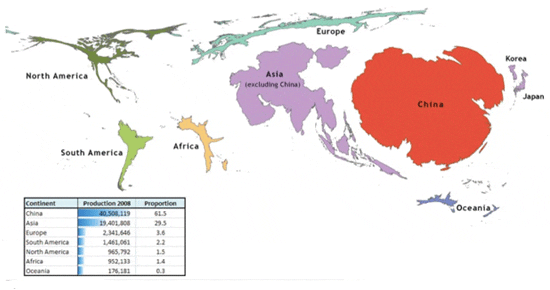
Life Cycle Analysis of Environmental Impacts
The report clearly identifies how environmental impact compares across systems and geographies, the species groups or production systems that are especially demanding on biophysical resources, and how environmental performance for similar systems differs among countries.
Absolute impact levels correlate well with overall levels of production. Globally inland pond culture is the predominant production system and contributes the greatest impact across all six impact categories. From a global perspective, the impacts of Chinese aquaculture, and carp culture in particular, stand out. Marine cage and pen fish farming are notable for biotic depletion due to their demand for wild fish. So is the production of shrimp, prawn and salmon due to the quantity of wild fish needed to produce acceptable fish food containing the necessary quantity and variety of oils and fats. Eel farming was shown to be particularly demanding in its energy requirements. In contrast, bivalve and seaweed production placed low demands on biotic resources and actually reduced eutrophication by absorbing nutrients from the water.
The results show the relative efficiencies in production by species, system and country. Of particular significance are the comparisons between species cultured in the same system in different countries. Here we find considerable variance. For more than half of the comparisons, the best performing nations showed more than 50 per cent lower impact levels than the worst performing nations. This is due to differences in production practices where farm level choices and management exert significant influence on impacts, and in systemic country-specific conditions (such as method of energy production) over which fish farmers often have little or no control.
Implications and policy recommendations
Policy reform and research are essential to reduce the overall environmental impact in regions suffering the most, i.e., Asia and particularly China.
Given the observed differences in species, system choices and management practices, there is potential for large improvements in efficiency. Shared learning of best practices across the industry offers significant opportunities to increase efficiencies. It is not surprising that the salmon industry showed least variation across both countries and impact categories. This is almost certainly due to the greater investments in salmon farming research, the global nature and competitiveness of the industry and the fact that the sector is dominated by a few large companies. Similar investment in research, combined with the right institutional, policy and market drivers, could lead to a dramatic improvement in performance in many other aquaculture systems.
New innovations are required to reduce the dependency of some aquaculture production systems on fishmeal and fish oil. This may be achieved by management changes that limit supply of fishmeal and oil to selected growth periods, or by the production of alternative vegetable based feeds that provide the necessary ingredients. Alternatively, through artificial selection, fish may be bred that have lower requirements for fishmeal and fish oils.
In most production systems electricity generation was shown to be the main contributor to acidification, energy demand and climate. Although energy use can be reduced by increases in efficiency, the method of production is largely a national policy issue and out of the direct control of farmers. The use of water and energy audits is recommended to encourage practices that reduce resource demands.

Comparing Aquaculture with Other Animal Food Production
Comparisons of the environmental costs of aquaculture with those of livestock are important to ensure that the animal food production sector develops in ways that use available resources wisely. Drawing extensively on the work of FAO, similar biophysical resource inputs and emissions were reviewed and environmental impacts were determined for dairy, poultry, pork and beef production.
Fish score well in terms of food conversion effciencies (Figure 3). They convert a higher percentage of the food they eat into consumable protein. This efficiency is partly a reflection of the fact that fish being cold blooded, do not use energy to maintain a high body temperature. As fish live in an aquatic environment they do not need as extensive a skeleton as terrestrial livestock and so there are more portions available as food. Efficiencies are most notable for fish species that feed low in the food chain, primarily on vegetable-based feeds. However, not all fish can be grown on this diet alone. Shrimp, prawns and salmonids, for example, require feeds with fishmeal and fish oil. Replacing fishmeal with land-based crops leads to increases in the use of land and water. It also produces a nutritionally inferior end product in which total lipid levels rise and lipid profiles shift to become dominated by less desirable omega-6 fatty acids. Concerns of overfishing of marine ecosystems arise with a growing demand for fishmeal and fish oil from capture fisheries.
On average, fish have a lower potential to cause eutrophication than pork or beef (Figure 4). The land area required to produce equivalent quantities of fish or meat were found to be broadly similar, but research from other authors has yielded contradictory results. This illustrates the complexity of comparative analysis between different animal production systems. Aquaculture use of water is variable and can, in fact be lower than other animal production systems (Figure 5). For example, coastal aquaculture makes use of sea water rather than fresh. Inland aquaculture ponds are drained and filled on a periodic basis but the water is often a form of water storage and seepage losses from ponds represent an ecosystem service, serving to recharge groundwater reserves.
Implications and policy recommendations
An important advantage of fish production is the greater efficiency of fish in converting feed to biomass. Evidence also suggests that aquaculture contributes less to global emissions of nitrogen and phosphorus than production of pork and beef. Aquaculture thus has clear advantages over other types of animal source food production for human consumption. Where resources are stretched, policies that promote fish farming over other forms of livestock production should be considered.
It is important to remember that there is trade-offs between different production systems and in the level of environmental impact from the various species groups.
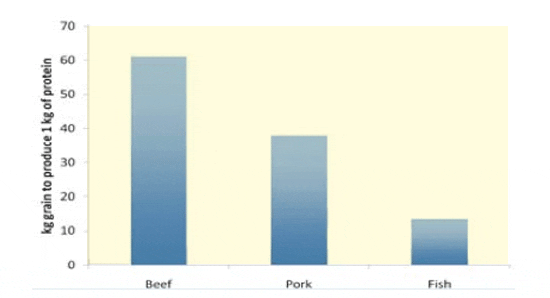
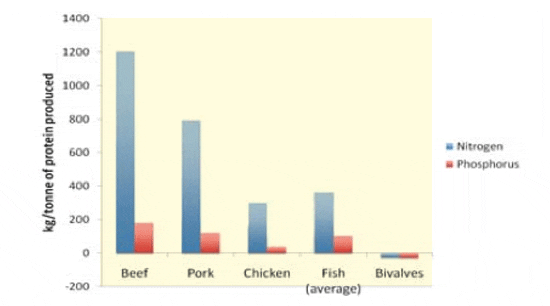
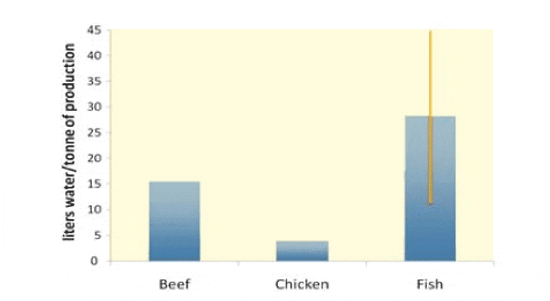
Projecting the Future of Aquaculture
Studies suggest that increasing prosperity and urbanization are the key factors driving demand for animal protein, including fish. Relative price of other protein sources and increased awareness of health benefits are relevant, but secondary elements. As incomes rise, demand for fish follows suit. Evidence also suggests that moving from a rural to an urban environment is associated with an increase in consumption of animal source foods.
By 2025, almost six out of ten people on Earth will live in urban centers, and over half of these will live in the cities of developing countries. China, India and the rest of Asia with their growing middle classes are where we can expect demand for fish to rise most significantly. The contribution of fish to food and nutrition security will become increasingly important in developing countries. This is particularly true for Asian and African countries where there is growing domestic and regional demand for fish, especially from the growing urban populations, including the urban poor.
There is a general consensus among published studies that the growth of global aquaculture production will continue along a trajectory similar to that of the recent past for at least the next five years. This results in an uncertainty envelope for production in 2020 estimated at between 65 and 85 million tonnes. Estimates that extend to 2030 have a wider margin of error, yielding a conservative range of 79 to 110 million tonnes.
The current distribution of production is likely to remain unchanged to at least 2015: Asia will account for more than 90 per cent of production; Europe for around three to four per cent; Latin America, North America and Africa for two per cent each and Oceania for only a fraction of a percentage point. Projecting regional distribution beyond this period is more problematic due to a variety of interrelated factors such as competition for resources and markets and changes in government policies that favor or obstruct growth.
Production in Europe and North America, which has remained largely static over the past decade, will probably not grow substantially due to lack of suitable new sites and competition from other producing countries. Growth in Africa is likely to be patchy. Private investment is driving rapid growth in Uganda, Nigeria and Ghana, but the very low production base and inefficient and poorly developed value chains indicate that at least a decade will pass before substantial increases in production are realized there.
Current trends indicate that the majority of the increase in global production to 2030 will come from South and Southeast Asia where India, Indonesia and Thailand will become increasingly larger producers. Major producer countries such as China and Vietnam will continue their drive towards export to European and North American markets. Other than markets, the principal constraint to production growth in the Asian region is likely to be availability of resources (land, water) and environmental change.
Life Cycle Analysis (LCA) models have been used to predict change in overall environmental impact (assuming that environmental production from aquaculture in 2030 reaches 100 million tons) for each of the six impact categories listed in Table 1. The largest projected change (+168 per cent) is for eutrophication. Meeting the demands for fish production in the future will therefore require particular attention to issues of waste disposal.
The geographical distribution of each impact category broadly corresponds to production levels, re-affirming the importance of focused support to Asian producers for mitigation of current and future environmental impacts of aquaculture.

How the rise in production can be achieved in an environmentally sustainable manner raises important issues. Environmental constraints to increased production will need to be met through a combination of science and technology and with an enabling but environmentally sensitive set of policies and procedures. These will be driven by three actors, the industry itself, driven to maintain ecological integrity and ensure that any environmental degradation does not lead to decreases in production; by governments who will need to regulate impacts such as the quantity and quality of effluent discharge, and the retail consumer through awareness (such as from certification schemes) and purchasing preferences.
The current dominant systems will undoubtedly continue to intensify. Intensification has historically been accompanied by serious environmental issues that include disease outbreaks, habitat loss, overuse of antibiotics leading to resistant strains of pathogens, and pollution of local populations caused by genetic escapes. Fortunately, evidence suggests that some of these issues characterize the early stages of industry development and that lessons have been learnt that can prevent or reduce the occurrence of similar future scenarios. Policy makers will need to establish operating environments in which regulators can ensure that best industry standards and FAO guidelines for aquaculture are followed.
As aquaculture production methods intensify and farms get larger and more spatially concentrated, there is increased risk from the spread of pathogens. Disease prevention can prove difficult and increased use of antimicrobials as prophylactics and growth promoters is likely. This will increase the likelihood that new, drug-resistant strains of pathogens will develop and also raises concerns for human health.
Several approaches will be needed to overcome these obstacles. Developing vaccines is one means of reducing use of medicines, but research in this area is currently restricted to relatively few species (e.g., salmon, trout, and grouper) and vaccines are only effective against certain types of disease.
Improved welfare standards will minimise stress on fish and reduce the incidence of disease. Well-enforced application of the environmental standards developed for many medicines will reduce the spread of pathogens. Food safety standards, designed to protect consumers from exposure to potentially harmful medicinal and other chemical residues, will force producers to stop using more persistent and harmful compounds and to use only approved compounds with due care and attention.
These standards are currently more widely used in developed countries and applied to products from developing countries for export. Developing countries will need to apply similar regulations to protect their domestic consumers. While industry codes of practice may help, legislation and legislation implementation, combined with capacity building, are also needed.
The majority of aquaculture production is currently from extensive and semi-intensive systems. Feed is predominantly crop based. However, the inevitable increase in intensification, coupled with growth in the current systems, will place increased demand on both crop-based and fishmeal resources. Increased demand for crop-based feeds will intensify competition with crops grown for human consumption. The use of trash fish (usually small pelagic species) in shrimp and carnivorous fish production has already been flagged as problematic because it exploits other marine resources, as reflected by the now stagnant rate of increase in capture fisheries.
Reducing the fishmeal and fish oil component in aquaculture feeds is a high priority for intensive and semi-intensive systems. Some recommendations for addressing this issue include the increased use of locally sourced agricultural by-products such as oil cakes and rice bran, and the development of pre-treatment methods that increase the digestibility and nutrient availability of the food source. Development of alternative sources of high quality feed from plants or microorganisms may offer another method of solving the problem. Better use of the high quality fishmeal and fish oil supplies may be made by restricting their inclusion in the diet to only those periods when they are essential, or by use only as finishing diets to improve the nutritional value of the product for the consumer. Future research may yield new feeding technologies and management systems that optimize the conversion of feeds into aquatic animal biomass, thus reducing the need to rely on fishmeal and fish oils.
Aquaculture will increasingly compete with other animal production sectors for use of feedstuff crops and agricultural by-products. The sector will continue to secure access only if it can afford the going rate and if the role of aquaculture in food security and economic development is sufficiently recognised to motivate an enabling policy environment.
Some increase in production is likely to result from use of fish strains selectively bred for increased growth rate, disease resistance and other traits. Results from selective breeding programs can be impressive: the selectively bred Jayanti strain of Labeo rohita (rohu) that is widely used by Indian farmers has shown the ability to grow (across a range of production environments) up to 17 per cent faster per generation over five generations compared with local strains. Though improved strains may reduce the level of impact on land and water use, they are unlikely to make a significant dent in the other impact categories: faster growing fish may simply eat more, rather than show any improvement in conversion efficiencies.
The incentives for use of non-native species in aquaculture remain high, particularly for developing countries. Future efforts will need to be directed towards improving risk assessment and mitigation measures. Based on the FAO Code of Conduct for Responsible Fisheries (1995) and the ICES Code of Practice on the Introductions and Transfers of Marine Organisms (2005), IUCN provides useful recommendations for national governments to implement responsible use of alien species in aquaculture.
The implications of climate change cannot be ignored. While aquaculture is a relatively small contributor to greenhouse gas generation, climate change will affect the industry. Rises in temperature are likely to cause changes to the physico-chemical environment that effect ecosystem processes. Productivity may rise to a point where temperature becomes a stress factor and production subsequently decreases. The most likely outcome is that the there will be a shift in the location of aquaculture from areas that have become unsuitable to new areas that will become more suitable.
Implications and policy recommendations
Aquaculture is likely to be an increasingly important contributor to food and nutrition security in developing countries where there is a culture of fish consumption. Governments and industry will need to stimulate investments in aquaculture where there is strong demand in domestic and regional markets; evaluate research and policy development needs along the entire value chain from inputs to consumer markets; support development of aquaculture that delivers sustained supplies at affordable prices for poor consumers and support aquaculture both as a household livelihood and as a food and nutrition security strategy in areas where production is feasible but markets are weak.
To reduce their carbon footprint, new aquaculture enterprises should not be located in areas that are high in sequestered carbon, such as mangroves, areas of seagrass, or forests. The industry needs to review on-farm energy use to inform efforts to decrease carbon dioxide emissions. Energy consumption associated with pumping and post- harvest processing, transport and marketing must be minimised. Organically enriched fish pond sediments, which are a potential source of methane, should be used for producing other foods.
General Conclusions and Core Recommendations
The demand for aquaculture products will continue to grow. The sector has the capacity to meet this increased demand by expanding to new areas and through intensification. The environmental impacts of such growth can be managed through innovation, strengthened policy, capacity building and monitoring. These core recommendations are offered to policy makers, development and environmental organisations, and industry professionals:
- Support innovation in the aquaculture sector, especially the development of technologies that make best use of land, water and feed resources and that minimize demands on environmental services.
- Ensure that the regulatory environment keeps pace with sector development and support policy analysis and development that internalise the costs of environmental impacts into aquaculture enterprises.
- Develop capacity in national agencies for sector regulation and for monitoring and compliance.
- Monitor carefully how supply and demand for fish is evolving to ensure that support and investment are appropriate to the market opportunity. These core recommendations apply globally, but there are regional differences in their relative importance over the next three to five years.
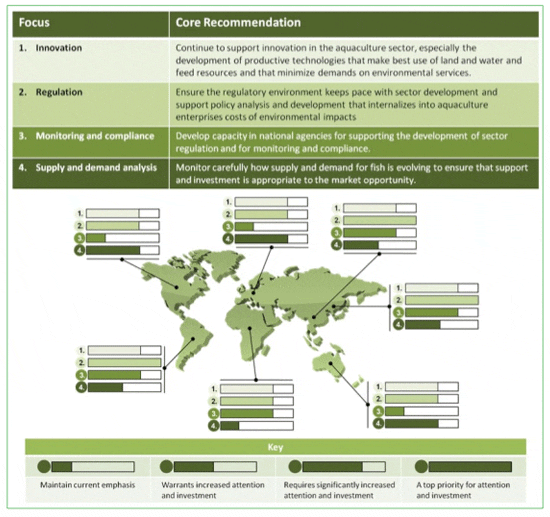
September 2011

